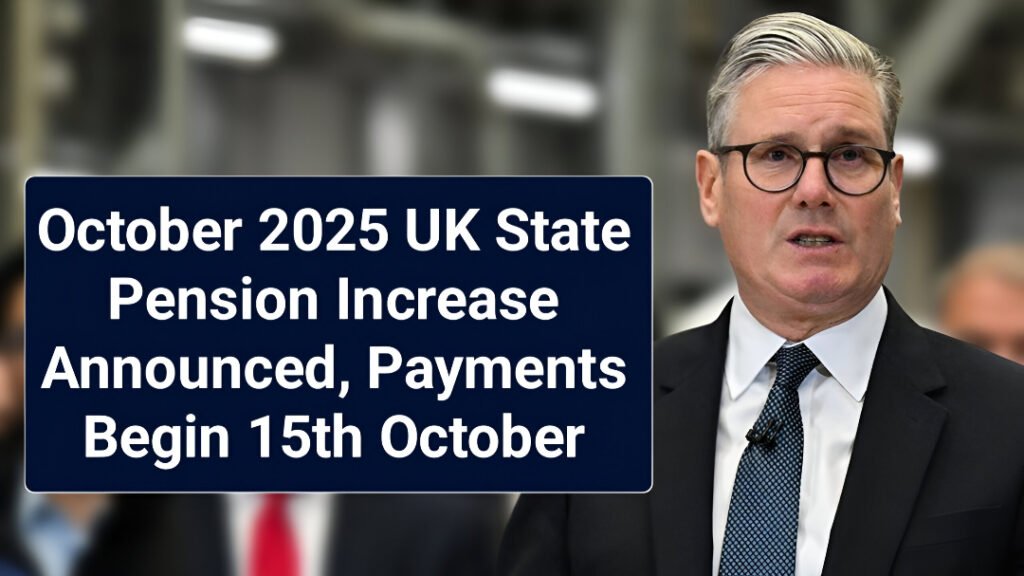Hello Everyone, The UK Government has confirmed that millions of pensioners will see a rise in their State Pension payments starting from 15th October 2025. The news comes as a relief for retirees struggling with living costs and inflation pressures. This increase aligns with the government’s ongoing commitment to supporting older citizens through the Triple Lock system. Here’s everything you need to know about the October 2025 State Pension rise, payment details, and what it means for your finances.
What the October 2025 Pension Rise Means
The Department for Work and Pensions (DWP) has officially announced that the UK State Pension will rise this October under the Triple Lock rule. This means pension payments will increase based on the highest of three factors — inflation, wage growth, or a fixed 2.5%.
The increase comes as part of the government’s mid-year adjustment to support pensioners during the ongoing cost-of-living challenges. For many, this could mean an extra few hundred pounds per year, depending on their pension type.
How Much Will the State Pension Increase?
While the exact percentage depends on the latest inflation data, early estimates suggest that the October 2025 rise could be around 4.2%. This figure is based on wage growth and recent inflation rates.
For pensioners receiving the new full State Pension, weekly payments are expected to rise from £221.20 to around £230.50, meaning an annual increase of nearly £480. Those on the basic State Pension could see their payments increase from £169.50 to around £176.60 per week.
Who Will Benefit from the Increase
This pension rise applies to all those receiving either the basic or new State Pension. It also benefits individuals who have deferred their pension or who receive Pension Credit and other related benefits. Key groups benefiting include:
-
Retirees currently drawing the State Pension
-
Pensioners who have deferred and plan to start claiming after 15th October
-
Individuals receiving additional pension supplements
This update provides crucial financial breathing space for millions of UK retirees amid high living costs.
When Payments Will Begin
Payments reflecting the new pension rates will start from Tuesday, 15th October 2025. However, the exact payment date will depend on each person’s National Insurance number and their regular payment schedule.
The DWP has clarified that some pensioners might receive their first increased payment a few days later, depending on bank processing times. All payments made after 15th October will automatically include the revised rates — there is no need to reapply or make any claims.
How to Check Your New Pension Amount
You can easily find out how much your pension will increase by using the UK Government’s Pension Forecast service online. The updated figures will be available before the first October payments are made. Steps to check your updated pension:
-
Sign in using your Government Gateway ID
-
View your new payment breakdown under “Future Pension Forecast”
This tool provides a full breakdown of your weekly, monthly, and annual payments after the increase.
Why the Increase Was Announced Now
Typically, pension adjustments are made in April each year, but the government has introduced an October update to counter rising inflation and household expenses.
The move follows discussions within the Treasury and DWP, aiming to help pensioners better manage bills, food costs, and heating expenses through the winter months. Reasons behind the October rise include:
-
Continued inflation pressure affecting pensioners’ savings
-
Rising energy bills during the winter season
-
Ensuring that retirees keep pace with wage growth
This mid-year boost demonstrates the government’s focus on protecting the financial stability of older citizens.
How the Triple Lock System Works
The Triple Lock is a government guarantee that ensures the State Pension increases each year by the highest of:
-
Average earnings growth
-
Inflation rate (as measured by CPI)
-
2.5% minimum rise
This system was introduced in 2010 to safeguard pensioners’ incomes and prevent their purchasing power from declining over time. Despite periodic debates about its cost, the policy remains a cornerstone of the UK’s pension framework.
Tips to Make the Most of the Increase
With a bit of planning, pensioners can maximise the benefit of this October’s increase. Consider reviewing your finances to ensure your money goes further during the winter. Simple financial tips:
-
Review your energy tariffs and switch to cheaper providers if possible
-
Check eligibility for additional benefits like Pension Credit or Winter Fuel Payment
-
Use budgeting tools from Age UK or MoneyHelper to manage monthly expenses
-
Explore local council schemes for senior citizens’ discounts
These small steps can make a big difference, especially during the colder months when costs tend to rise.
Government Reaction and Public Response
The October 2025 announcement has been widely welcomed by pensioner advocacy groups. Organisations like Age UK and the National Pensioners Convention praised the decision as a timely relief for millions of older people.
However, some critics argue that the increase may still fall short of covering essential expenses given ongoing inflation. The government maintains that further adjustments will be reviewed in April 2026, in line with the standard schedule.
Public sentiment overall remains positive, with many pensioners expressing gratitude for the government’s swift response to cost-of-living pressures.
Conclusion
The October 2025 UK State Pension increase is a welcome boost for millions of retirees across the country. Starting from 15th October, the higher payments will help pensioners cope with inflation, energy costs, and day-to-day living expenses. With the Triple Lock in place, the government continues to uphold its promise to protect pensioners’ incomes and maintain financial stability during challenging times.
